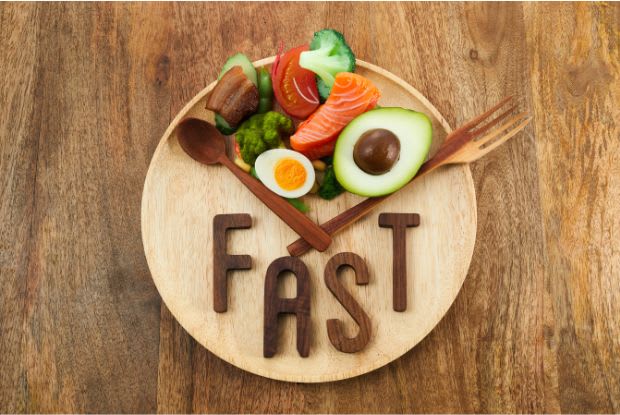Science-Backed Diet Tips for Burning Fat
Science-Backed Diet Tips for Burning Fat
Table of Contents
I. What Is the Best Diet to Lose Belly Fat?
II. What Is the Best Diet for Weight Loss?
A growing waistline has become a troubling reality for many Americans. According to the Centers of Disease Control and Prevention, nearly half of the adult population in the U.S. is obese. 1 While our activity levels have largely stayed the same over the years, our calorie intake has steadily risen. Food is more readily available and convenient than ever before. 2
The key to shedding fat comes down to a simple equation: consume fewer calories than you burn. In this article, we will focus on the consumption side of the equation and provide some of the best ways to cut calories while improving nutrition. We will also discuss popular weight loss diets such as intermittent fasting, the keto diet, and the Mediterranean diet.
What Is the Best Diet to Lose Belly Fat?
Unfortunately, spot reduction of fat through a belly fat diet is not possible. While losing weight overall will help shrink belly fat, you cannot target belly fat through diet or exercise. 3
When we consume fats, our bodies convert any unused energy into triglycerides, which are then stored in fat cells called adipocytes. These triglycerides are then transported to adipose tissue, also known as body fat, throughout our bodies. 3
While body fat is found all over our bodies, it's primarily stored as:
- Subcutaneous fat: This is located under our skin.
- Visceral fat: This is fat around our internal organs. 3
When our bodies need to tap into fat stores for energy, such as during exercise or fasting, a process called lipolysis breaks down triglycerides into free fatty acids and glycerol. These components travel through the bloodstream to muscles throughout the body to be used as fuel. Because the fatty acids come from fat cells all over the body, spot reduction of fat in specific areas is physiologically impossible. 3
Research also confirms that exercising for spot reduction is a myth:
- A 12-week study found no greater belly fat loss in those doing abdominal exercise and dieting versus dieting alone. 4
- A 2021 analysis of 13 studies with over 1,100 people found no localized fat loss from exercising a specific body part. 5
While genetics account for about 60% of where we store fat, other factors like age, gender, and hormones also impact where and how readily our bodies store and mobilize fat. 6 But no diet or exercise can override our physiology to spot reduce fat from a specific body part. 3
What Is the Best Diet for Weight Loss?
The best diet for weight loss is one that you can maintain long-term. When putting together a weight loss diet plan, there are a few key steps to follow.
First, calculate how many calories you need each day. You can do this with a few simple calculations:
- Calculate your maintenance calories: Multiply your current weight by 15 to estimate the calories needed to maintain your current weight with moderate activity levels.
- Reduce this number by 500 to 1,000 calories: This will give you the number of daily calories you need to lose one to two pounds per week. 7
When deciding on daily calorie limits, women should not go below 1,200 calories per day and men 1,500 calories per day without medical supervision. Consuming too few calories can lead to nutrient deficiencies. 7
In addition to calories, calculate the amount of fats, carbohydrates, and protein you need.
- Protein: The American Dietetic Association recommends 0.8 to 1 gram of protein per kilogram of body weight. For a 168-pound person, that is 61 to 76 grams per day.
- Fat: Fat intake should constitute around 30% of your total daily caloric intake, with each gram of fat contributing 9 calories. For example, if your daily calorie goal is 1600, your fat intake should be around 53 grams per day.
- Carbohydrates: The USDA recommends that 45 to 65% of your daily caloric intake should be carbohydrates. 8
Following these guidelines for daily calories and macronutrients will help create a balanced and maintainable diet geared towards healthy weight loss. The key is finding a plan you can stick to long-term, with appropriate calorie reduction and nutrient targets.
Intermittent Fasting

An intermittent fasting diet focuses on when you eat, not just what you eat. This diet involves alternating between periods of fasting and eating.
- Fasting period: During fasting periods, only water and zero-calorie drinks like black coffee or tea are allowed.
- Eating period: When it is time to eat, you do not have free reign to go overboard. Research shows that you are unlikely to lose weight if you use your eating window to consume high-calorie and unhealthy food. 9
There are a few different intermittent fasting approaches, but they all involve choosing scheduled times for fasting and eating.
- 16/8 fasting: The daily method limits eating to an eight-hour window each day. For example, you might eat only between noon and 8 p.m., then fast for 16 hours until noon the next day.
- 5:2 fasting: The weekly method involves eating normally five days a week and limiting yourself to one 500- to 600-calorie meal on the other two days. For instance, you might eat regularly every day except Mondays and Fridays, when you have only one meal. 9
Intermittent fasting allows your body to achieve a state called metabolic switching. This is when your body uses up its stored sugar and begins burning fat for energy. With a typical American eating schedule of three meals plus snacks, your body constantly uses new calories from food and does not tap into fat stores. 9
It can take two to four weeks to adjust to intermittent fasting. At first, you may feel hungry or irritable as your body adapts. However, intermittent fasting gets easier with regular practice and consistency. 9
Keto Diet
The keto diet has become a popular way to lose weight fast, but it's important to understand how it works and the potential risks before trying it.
A keto eating plan is centered around fat, which provides about 90% of calories each day. By severely limiting carbohydrates and eating plenty of fat, the goal is to put your body into ketosis. When this happens, your body switches from burning carbs for fuel to burning fat and producing ketones for energy instead. 10
While the keto diet was originally used to help reduce seizures in children with epilepsy, it has become widespread for weight loss purposes. However, it’s best to view the keto diet as a short-term solution to jumpstart weight loss rather than a long-term eating approach. 10
Here’s what you need to know about how the keto diet works:
- To put your body into ketosis, you must restrict net carbs to 20 to 50 grams per day. This means limiting sources like grains, starchy vegetables, legumes, fruit, milk, and sweets.
- It typically takes a few days of very low carb eating to reach ketosis.
- Consuming too much protein can also interfere with ketosis. 10
Research shows the keto diet can promote weight loss. A meta-analysis of eleven studies found the keto diet led to greater weight loss and reductions in triglycerides and blood pressure compared to low-fat diets. It also resulted in better long-term weight loss maintenance. 11
However, there are several potential health risks to be aware of with long-term keto dieting:
- Nutrient deficiencies can occur since you eliminate many nutritious carb sources. This includes possible deficiencies in selenium, magnesium, phosphorus, and vitamins B and C.
- Existing liver conditions may worsen due to excess fat intake.
- Kidney problems can occur from the increased protein load.
- Constipation is common since keto limits high-fiber foods.
- Low blood sugar risks occur, especially for diabetics on medication. 10
If you are interested in trying the keto diet, be sure to discuss it with your doctor first, especially if you have an existing health condition. While keto can be helpful for short-term weight loss, it's best to view it as a temporary eating approach rather than a lifelong diet due to the potential health risks. 10
Mediterranean Diet

The Mediterranean diet is a healthy eating pattern that emphasizes plant-based foods, healthy fats, and lifestyle habits practiced in the regions surrounding the Mediterranean Sea. 12 While specific foods differ across regions, the diet emphasizes eating:
- Vegetables and fruit
- Whole grains
- Legumes
- Nuts and seeds
- Olives
- Fish and poultry (in moderate amounts)
- Olive oil as the main source of fat
- Moderate intake of wine, typically enjoyed with meals 12
Beyond the focus on nutritious whole foods, the Mediterranean diet also promotes an overall healthy lifestyle. This includes:
- Being physically active
- Getting enough rest
- Sharing meals with others 12
Studies have demonstrated the positive impact of the Mediterranean diet on weight management. A comprehensive analysis of 19 research studies involving 3,436 participants revealed that the Mediterranean diet:
- Reduced body weight
- Reduced body mass index (BMI) 13
The weight loss effects were amplified when the Mediterranean diet was paired with regular physical activity and compliance to recommended daily calorie ranges. 13
Conclusion
With the vast array of diets to choose from, finding one that works for your weight loss goals can be challenging. However, the best weight loss diet or belly fat diet is one that you can adhere to long-term without feeling deprived. Extremely low-calorie or restrictive fad diets often lead to initial weight loss, but the pounds almost always return once normal eating resumes. For sustainable weight management, opt for a balanced diet paired with regular exercise.
If you are consistently making healthy lifestyle changes but are still struggling to lose weight, consult your doctor about weight loss medications. When combined with diet and exercise, these medications can help support your weight loss efforts. To learn how to make healthy lifestyle changes for weight loss, visit ScriptsMD's dedicated weight loss blog.
References
- CDC Key Findings
- Cutler, D., Glaeser, E., & Shapiro, J. Why have Americans become more obese?
- The University of Sydney Spot reduction: Why targeting weight loss to a specific area is a myth
- Kordi, R., Dehghani, S., Noormohammadpour, P., Rostami, M., & Mansournia, M. A. Effect of abdominal resistance exercise on abdominal subcutaneous fat of obese women: A randomized controlled trial using ultrasound imaging assessments
- Ramirez-Campillo, R., Andrade, D. C., Clemente, F. M., Afonso, J., Pérez-Castilla, A., & Gentil, P. A proposed model to test the hypothesis of exercise-induced localized fat reduction (spot reduction), including a systematic review with meta-analysis
- Schleinitz, D., Böttcher, Y., Blüher, M., & Kovacs, P. The genetics of fat distribution
- Harvard Health Calorie counting made easy
- Kansas State University What are my calorie, protein, fat, & carbohydrate needs
- Johns Hopkins Medicine Intermittent fasting: What is it, and how does it work?
- Harvard Health Should you try the keto diet?
- Masood, W., Annamaraju, P., Suheb, M., & Uppaluri, K. Ketogenic diet
- Dieticians of Canada The Mediterranean Diet: A Guide to Healthy Eating
- Esposito, K., Kastorini, C.-M., Panagiotakos, D. B., & Giugliano, D. Mediterranean diet and Weight Loss: Meta-analysis of randomized controlled trials
